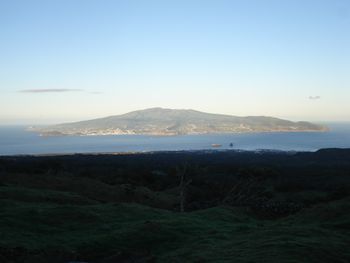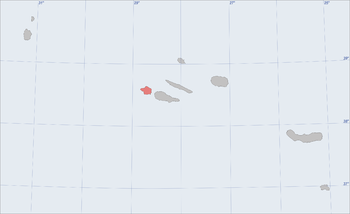جزيرة فايال
جزيرة فايال (Faial Island ؛ النطق في البرتغالية: [fɐˈjaɫ])، والتي تُعرف أيضاً في الإنگليزية Fayal هي جزيرة برتغالية of the Central Group (Portuguese: Grupo Central) of the Azores. The Capelinhos Volcano, the westernmost point of the island, might as well be the westernmost point of Europe, if the Monchique Islet, near Flores Island, is considered part of North America, for it sits on the North American Plate.
الاسم الأصلي: Ilha do Faial | |
|---|---|
 Island of Faial, as seen from the summit of the island of Pico | |
 Location of the island of Faial in the archipelago of the Azores | |
| الجغرافيا | |
| الموقع | Atlantic Ocean |
| الإحداثيات | 38°34′33″N 28°42′45″W / 38.57583°N 28.71250°WCoordinates: 38°34′33″N 28°42′45″W / 38.57583°N 28.71250°W |
| المساحة | 173.06 km2 (66.82 sq mi) |
| الطول | 21٫20 km (13٫173 mi) |
| العرض | 16٫29 km (10٫122 mi) |
| الإدارة | |
| Autonomous Region | Azores |
| السكان | |
| اسم المواطن | Faialense |
| التعداد | 14,875 (2001) |
| الجماعات العرقية | Portuguese |
With its nearest neighbours, Pico (east across the channel) and São Jorge (northeast across the channel), it forms an area commonly known as the Triângulo (English: Triangle). The island has also been referred to as the Ilha Azul (English: Blue Island), derived from the writings of Portuguese poet Raul Brandão, due to the large quantity of hydrangeas that bloom during the summer months:
"The man that had the idea to border the road with these plants should have a statue on the island. In no other place, do they prosper better: they need a covering of light, humidity and heat...they are in their place. Their blue, is the blue that adorns the Azores on lipid days...this is a blue that is even more blue, the bunches of flowers of a colour more intense and more fresh. They are in every direction: rising along the roads and the fields forming hedges; they serve to divide the parcels and to cover the peaceful animals."
— Raul Brandão، As Ilhas Desconhecidas (1926), p.33
. . . . . . . . . . . . . . . . . . . . . . . . . . . . . . . . . . . . . . . . . . . . . . . . . . . . . . . . . . . . . . . . . . . . . . . . . . . . . . . . . . . . . . . . . . . . . . . . . . . . . . . . . . . . . . . . . . . . . . . . . . . . . . . . . . . . . . . . . . . . . . . . . . . . . . . . . . . . . . . . . . . . . . . .
التاريخ
The people of Faial were active participants in the struggles between the Liberals and Absolutionists, finally deciding to favor the Liberals, welcoming the visit of King Pedro IV in 1832. For its loyalty, Horta was elevated to status of town.
الجغرافيا
The mineral fayalite is named for this island, having been first identified and described here in 1840. It is an iron-rich expression within the olivine family.
المناطق البيئية والمحمية
انظر أيضاً
- قائمة البراكين في الآزور
- كوندور، الجبل الغاطس، جبل تحت المحيط يقع على بعد 17 كم غرب-جنوب غرب جزيرة فايال.
المراجع
- الهامش
- المصادر
- Daniel, Luís; Soares, Natacha, eds. (2003). Faial, Açores: Guia do Património Cultural [Faial, Azores: Guide to the Cultural Heritage] (in Portuguese). Horta (Azores), Portugal: Atlantic View – Actividades Turísticos, Lda.
{{cite book}}: CS1 maint: unrecognized language (link) - Caldas, J.V. (2000). Atlântida, vol.XLV. Instituto Açoreano de Culutra, Angra do Heroísmo.
- Frutuoso, G. (2003). Saudades da Terra, Vol.6. Instituto Culutral de Ponta Delgada.
- Lucidus (1988). Atlas Turístico: Açores. Lucidus Publicações, Lda., Lisbon.
- Scarth, A.; J.C. Tanguy (2001). Volcanoes of Europe. Oxford University Press. p. 243 pp. ISBN 0-19-521754-3.
- Tostões, A.; F.J. Silva; J. Vieira; M. Lurdes Janeiro; N. Barcelos; V. Mestre (1989). Arquitectura Popular dos Açores. Ordem dos Arquitectos, Ponta Delgada.
- Brandão, Raul (1926). As Ilhas Desconhecidas [The Unknown Islands] (PDF). Lisbon, Portugal: Livrarias Aillaud & Bertrand. Archived from the original on 2014-09-25.
{{cite book}}: CS1 maint: bot: original URL status unknown (link) - You must specify vnum when using {{cite gvp}}.
- Machado, Adriane; Azevedo, José M. M.; Alemeida, Delia P.M.; Farid Chemale Jr. (2008). "Geochemistry of Volcanic Rocks from Faial Island (Azores)" (PDF). 5 (1). Lisbon: e-Terra, GEOTIC – Sociedade Geológica de Portugal: 1–14. Archived from the original (PDF) on 2011-05-11. Retrieved 2010-04-16.
{{cite journal}}: Cite journal requires|journal=(help) - Rocha, Gilberta Pavão Nunes (2007). "A população da ilha do Faial no contexto açoriano 1950–1970" [Faial Population in the Azorean Archipelago 1950–1970] (PDF) (in Portuguese). 16. Horta (Azores), Portugal: Boletim do Núcleo Cultural da Horta: 117–136.
{{cite journal}}: Cite journal requires|journal=(help)CS1 maint: unrecognized language (link)
